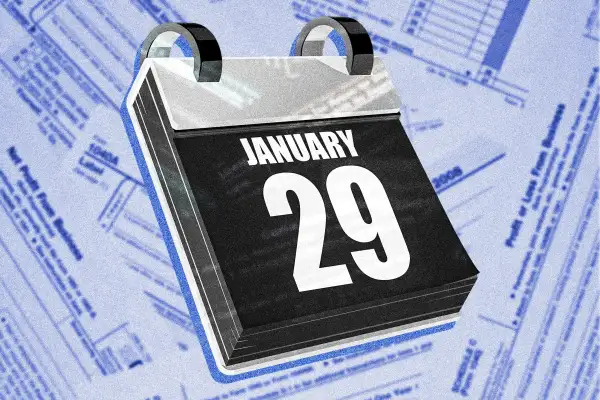Tax Season Starts Today — Here Are Key Dates to Help Get Your Refund Fast

Ready or not, it's time to file your taxes. The IRS is officially open for business — as of Monday, it is accepting and processing 2023 income tax returns.
The IRS announced the tax season start date earlier this month, adding that it’s anticipating getting more than 128 million returns by the April 15 deadline. Thanks to a massive infusion of cash from 2022's Inflation Reduction Act, the agency also vowed that taxpayers will continue to see customer service improvements during the 2024 filing season.
“For months, IRS employees have been working hard to be ready to help taxpayers and make tax season as easy and smooth as possible,” IRS Commissioner Danny Werfel said in a Monday news release.
Those plans include expanded in-person services available to help taxpayers. Much shorter wait times are expected for the IRS’s phone helpline, and with enhanced paperless processing, taxpayers will be able to submit more documents digitally. Taxpayers can also look forward to improvements to the Where’s My Refund? tool. And crucially, a new tax filing service, Direct File, will allow eligible taxpayers in some states to file their returns for free directly with the IRS.
The agency is going through a major transformation after a rough few years of challenges stemming from its aging infrastructure and COVID-19, like processing center closures, high staff turnover and a huge backlog of paperwork. Though the Inflation Reduction Act originally increased the agency’s budget by $80 billion over the next decade, deals struck between Republican leaders and President Joe Biden have since reneged over $21 billion of that funding.
Here’s everything you need to know for a successful tax filing season.
How early can I file my taxes?
You can file your taxes whenever you have the right tax forms. Many tax prep services rolled out their software for the 2024 tax filing season early. For instance, Intuit, which owns TurboTax, and TaxSlayer launched their service offerings for 2023 taxes in November.
Crucially, you may not have received all the paperwork you need to file just yet. Before you get started, you’ll need to make sure you have forms like your W-2 or 1099-NEC, which are scheduled to be sent out by the end of January. If you file too early and later receive a form you realize needs to be included, you'll have to amend your tax return.
What's the IRS Free File income limit for 2024?
The IRS Free File program, which allows eligible taxpayers to get guided help with filing their taxes from name-brand companies at no cost, opened on Jan. 12. The income limit to qualify for the service has risen to $79,000 for 2023 tax returns, which is an historically large increase from $73,000 for 2022.
Many taxpayers will be able to file for free through the IRS Direct File pilot, which will be rolled out incrementally as it undergoes final testing, according to the IRS. The agency expects the program to become widely available in mid-March to eligible taxpayers in 13 participating states.
Eligibility depends on location, income and your tax credits and deductions. If you don’t have a simple tax return (as in Form 1040 only, without additional forms and schedules), you most likely won’t be able to use Direct File.
Initially, Direct File will only accept individual federal tax returns, but if you want to file a state return after submitting your federal one, Direct File will redirect you to a state-supported tool that allows you to do so. (Arizona, California, Massachusetts and New York have agreed to integrate their state taxes into the pilot program. You may also be eligible if you live in one of the nine states that doesn’t impose an income tax.)
You can read more about Direct File and who may be eligible to file for free in this breakdown from Money.
When are taxes due in 2024?
For most taxpayers, the tax filing deadline is Monday, April 15, this year.
If you live in Maine or Massachusetts, your deadline is April 17 due to the Patriot’s Day and Emancipation Day holidays. You may also have additional time to file if you live in a federally declared disaster area.
Think you’ll need more time to file? You can submit Form 4868 to request an extension electronically through Free File, which would push your deadline back to Oct. 15. Just know that more time to file doesn’t mean you’ll have more time to pay the IRS what you owe.
How long will it take to get my tax refund in 2024?
Typically, the IRS issues tax refunds for most taxpayers within 21 days.
If your return is more complicated or you submit a paper return, it can take longer, and the agency can’t send out refunds for returns that claimed the earned income tax credit or additional child tax credit before mid-February. The IRS says taxpayers who claim those credits can plan on receiving their refunds by Feb. 27 this year.
The fastest way to get your return is by filing electronically and selecting the direct deposit option for the delivery method. You can check the status of your tax refund through the agency’s Where’s My Refund? tool on IRS.gov or the IRS2Go app, which will ask for your Social Security or taxpayer ID number, filing status and refund amount.
More from Money:
This Money Checklist Will Help You Crush 2024
Avoid These 7 New-Year Money Mistakes That Could Doom Your Resolutions
The 10 Hottest Housing Markets in 2024, According to Zillow Predictions

